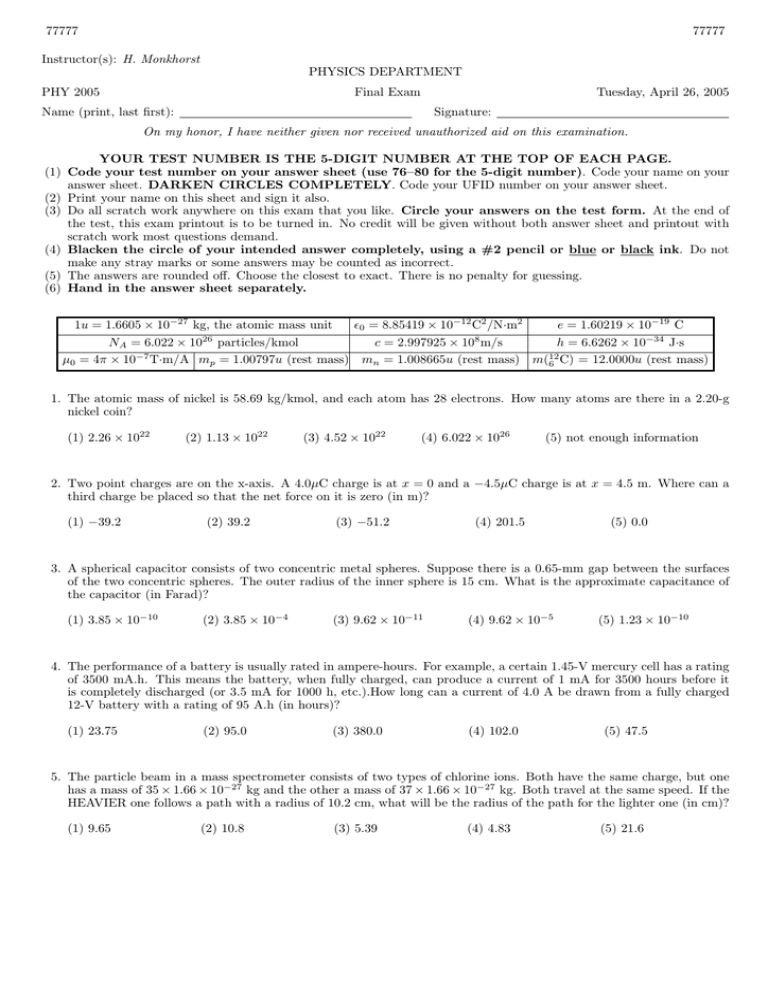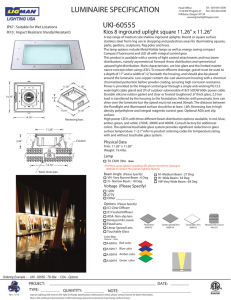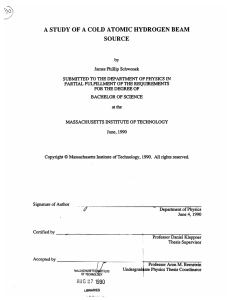77777 H. Monkhorst PHYSICS DEPARTMENT PHY 2005
advertisement

77777 77777 Instructor(s): H. Monkhorst PHYSICS DEPARTMENT PHY 2005 Final Exam Tuesday, April 26, 2005 Name (print, last first): Signature: On my honor, I have neither given nor received unauthorized aid on this examination. YOUR TEST NUMBER IS THE 5-DIGIT NUMBER AT THE TOP OF EACH PAGE. (1) Code your test number on your answer sheet (use 76–80 for the 5-digit number). Code your name on your answer sheet. DARKEN CIRCLES COMPLETELY. Code your UFID number on your answer sheet. (2) Print your name on this sheet and sign it also. (3) Do all scratch work anywhere on this exam that you like. Circle your answers on the test form. At the end of the test, this exam printout is to be turned in. No credit will be given without both answer sheet and printout with scratch work most questions demand. (4) Blacken the circle of your intended answer completely, using a #2 pencil or blue or black ink. Do not make any stray marks or some answers may be counted as incorrect. (5) The answers are rounded off. Choose the closest to exact. There is no penalty for guessing. (6) Hand in the answer sheet separately. 1u = 1.6605 × 10−27 kg, the atomic mass unit ²0 = 8.85419 × 10−12 C2 /N·m2 e = 1.60219 × 10−19 C NA = 6.022 × 1026 particles/kmol c = 2.997925 × 108 m/s h = 6.6262 × 10−34 J·s µ0 = 4π × 10−7 T·m/A mp = 1.00797u (rest mass) mn = 1.008665u (rest mass) m(12 6 C) = 12.0000u (rest mass) 1. The atomic mass of nickel is 58.69 kg/kmol, and each atom has 28 electrons. How many atoms are there in a 2.20-g nickel coin? (1) 2.26 × 1022 (2) 1.13 × 1022 (3) 4.52 × 1022 (4) 6.022 × 1026 (5) not enough information 2. Two point charges are on the x-axis. A 4.0µC charge is at x = 0 and a −4.5µC charge is at x = 4.5 m. Where can a third charge be placed so that the net force on it is zero (in m)? (1) −39.2 (2) 39.2 (3) −51.2 (4) 201.5 (5) 0.0 3. A spherical capacitor consists of two concentric metal spheres. Suppose there is a 0.65-mm gap between the surfaces of the two concentric spheres. The outer radius of the inner sphere is 15 cm. What is the approximate capacitance of the capacitor (in Farad)? (1) 3.85 × 10−10 (2) 3.85 × 10−4 (3) 9.62 × 10−11 (4) 9.62 × 10−5 (5) 1.23 × 10−10 4. The performance of a battery is usually rated in ampere-hours. For example, a certain 1.45-V mercury cell has a rating of 3500 mA.h. This means the battery, when fully charged, can produce a current of 1 mA for 3500 hours before it is completely discharged (or 3.5 mA for 1000 h, etc.).How long can a current of 4.0 A be drawn from a fully charged 12-V battery with a rating of 95 A.h (in hours)? (1) 23.75 (2) 95.0 (3) 380.0 (4) 102.0 (5) 47.5 5. The particle beam in a mass spectrometer consists of two types of chlorine ions. Both have the same charge, but one has a mass of 35 × 1.66 × 10−27 kg and the other a mass of 37 × 1.66 × 10−27 kg. Both travel at the same speed. If the HEAVIER one follows a path with a radius of 10.2 cm, what will be the radius of the path for the lighter one (in cm)? (1) 9.65 (2) 10.8 (3) 5.39 (4) 4.83 (5) 21.6 77777 77777 6. Two parallel wires lie 6.5 cm apart on a table-top. They carry currents of 25 A in the same direction. Find B at the position of one wire due to the other (in T). (1) 7.69 × 10−5 (2) 61.2 (3) 4.83 × 10−4 (4) 7.69 (5) 4.83 7. A flat rectangular board is 25 × 35 cm. It is placed in a 0.250-T field in such a way that a perpendicular to the board’s surface makes an angle of θ = 36◦ to the field. Find the magnetic flux through the board (in T·m2 ). (1) 1.770 × 10−2 (2) 1.77 (3) 2.19 × 10−2 (4) 1.286 × 10−2 (5) 0.0 8. An uncharged 2-µF capacitor is connected in series with a switch, a 5 × 107 Ω-resistor, and 12-V battery. Find the current in the circuit just after the switch is closed (in A), and the charge on the capacitor after one time constant (in C). (1) (2.4 × 10−5 , 1.51 × 10−5 ) (2) (2.4 × 10−5 , 0) (3) (0, 0) (4) (1.51 × 10−5 , 0) (5) (0, 2.4 × 10−5 ) 9. What frequency should a radio station have if its waves are to have a wave length of 300 m (in MHz)? (1) 1.0 (2) 10.0 (3) 10−6 (4) 5.0 (5) 300 10. A certain search light beam provides an illuminance of 30,000 lx close to the search light. The beam there has a cross-sectional area of 2.5 m2 . The beam spreads somewhat as it travels away from the light source. What illuminance does it provide at the position where its cross section has increased to 8.5 m2 (in lx)? (1) 8,823 (2) 102,000 (3) 30,000 (4) 20,000 (5) 40,500 11. A beam of light strikes a flat glass plate at an angle of incidence of 76◦ . The glass’s index of refraction is 1.61. Find the angle of refraction in the glass, and the angle of refraction of the beam as it exits from the glass into the air (in degrees). (1) (37.1, 76) (2) (76, 37.1) (3) (45, 45) (4) (76, 76) (5) (37.1, 37.1) 12. In a certain slide projector, the object (the slide) is placed 13 cm from the projection lens. The image appears sharp on a screen 4.5 m away from the lens. What is the focal length of the lens (in m), and what is the magnification of this system? (1) (0.126, −34.6) (2) (0.126, 34.6) (3) (−0.126, −34.6) (4) (−0.126, 34.6) (5) (0.126, 1.0) 13. A magnifying glass with a 9.2-cm focal length is used to look at an object. Where should the object be placed if the image is to be 25 cm behind the lens(in cm)? (1) 6.725 (2) −6.725 (3) 25.0 (4) 9.2 (5) at infinity 14. Two identical loud speakers (i.e., with identical frequencies and identical amplitudes) send sound waves out along the x axis to a listener at x = 25 m. The speakers are at x = 0 and x = 1.75 m. The frequency of the two speakers is slowly increased from a very low value. Give the first two wavelengths (in m) at which WEAK sound will be heard. (1) (3.50, 1.167) (2) (1.75, 3.50) (3) (3.50, 7.00) (4) (6.31, 8.25) (5) (5.25, 10.5) 77777 77777 15. In present-day nuclear accelerators, protons can be accelerated through 5 × 109 V. What is the ratio m/m0 for such a proton, and how fast, in units of c, is the proton moving? (1) (6.325, 0.987) (2) (1.000, 1.000) (3) (5.432, 0.995) (4) (3.162, 0.951) (5) (5.012, 0.853) 16. The work function of tungsten is 4.9 eV. What is the photoelectric threshold wavelength for tungsten (in nm)? (1) 253 (2) 506 (3) 126 (4) 625 (5) 1265 17. A nuclear power reactor is 35% efficient when it produces 150,000,000 W electricity. How much mass is converted to energy in one hour of operation (in kg)? (1) 1.72 × 10−5 (2) 3.44 × 10−5 (3) 3.44 × 10−3 (4) 1.72 × 10−3 (5) 1.72 × 105 18. Oxygen as found in nature consists of three isotopes: 99.762% have atomic mass 15.99491 u, 0.038% have atomic mass 16.9991 u and 0.200% have atomic mass 17.9992 u. Find the atomic mass the chemists list for this element (in u). (1) 15.9993 (2) 16.9991 (3) 17.9992 (4) 15.9949 (5) 16.0000 19. From a consideration of energy alone, could the following decay occur: p → n +0+1 β? The mass of a positron is 0.00055 u. If so, what is the energy released (in MeV)? (1) (no, none) (2) (yes, 5.1) (3) (yes, 2.1) 20. How much energy is needed to separate all nucleons in (1) 92.97 (2) 46.46 (3) 185.94 12 6 C (4) (yes, 3.2) (5) (no, 7.3) (in MeV)? (4) −92.97 (5) 2.979 × 10−11





